 This information has been archived for reference or research purposes.
This information has been archived for reference or research purposes.
Archived Content
Information identified as archived on the Web is for reference, research or recordkeeping purposes. It has not been altered or updated after the date of archiving. Web pages that are archived on the Web are not subject to the Government of Canada Web Standards. As per the Communications Policy of the Government of Canada, you can request alternate formats on the "Contact Us" page.
Canada and the World
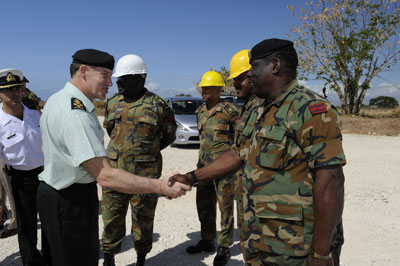
DND Photo IS2009–1005–18 by Sergeant Paz Quillé
The Chief of the Defence Staff (CDS), General Walt Natynczyk, meets with Jamaica Defence Force staff during Exercise Tropical Hammer, 27 March 2007.
Canada and the Americas: Defending our Neighbourhood
by General Walter Natynczyk, CMM, MSC, CD with Nancy MacKinnon
For more information on accessing this file, please visit our help page.
Introduction
When Canadians think about their place in the world, whether politically or geographically, they tend to look east to Europe, west to Asia, and south to the United States. But typically, they don’t normally identify countries south of the Rio Grande as those with whom Canada may share common interests and issues. But as I was reminded during my visits throughout the Americas in the last year – I was fortunate to visit Haiti, Jamaica, Colombia, Uruguay, Brazil, and Mexico – Canada is very much a country of the Americas. This is our neighbourhood. And the region is a place of much promise and potential for Canada, so it is not surprising that it is of increasing importance to the Government of Canada.
The Prime Minister has been clear that our re-engagement in the hemisphere is a national priority. The 2007 Speech from the Throne identified the Americas as one of Canada’s foreign policy priorities, and highlighted that Canada would play an active role in the region. The Government has developed a strategy for enhanced engagement in the Americas to guide its endeavors in the hemisphere, and the Canadian Forces have a role to play in advancing the Government’s agenda under the security pillar of our engagement. To put it another way, the Americas are Canada’s neighbourhood, and, from a defence perspective, we intend to be a good neighbour.
These last two years have witnessed important demonstrations of this commitment. For instance, the Canadian Forces played a significant role in Canada’s comprehensive response to the devastating earthquake in Haiti earlier this year, deploying approximately 2000 military members to assist with humanitarian response, including the Disaster Assistance Response Team (DART), a military field hospital, ships, helicopters, and army personnel. And in September 2008, Canada hosted the VIIIth Conference of Defence Ministers of the Americas in Banff, Alberta, which I was fortunate to attend. This highly successful conference invited 34 ministers from across the hemisphere to meet in a collegial atmosphere to discuss important defence and security matters. Bringing these ministers together to talk is important, but it has not always been easy or constructive in this diverse and complex region.
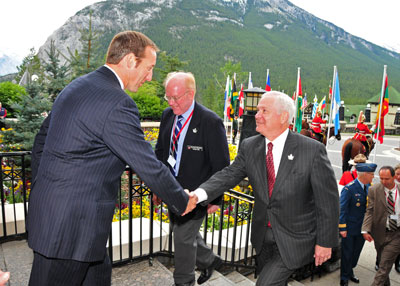
DND photo ISX2008–0028 by David Snashall
The Honourable Peter Gordon Mackay, Minister of National Defence (MND), welcomes US Secretary of Defense Robert Gates to the 8th Conference of Defence Ministers of the Americas, Banff, Alberta, 2 September 2008.
The security and defence issues affecting the region are complex, and must be addressed with a number of different tools and measures. But armed forces are only one of the tools in the toolbox, and they are not always the one that is most needed. As we in the Canadian Forces and Department of National Defence consider the security and defence challenges in the Americas, we are guided by a fundamental approach to our relationships with our partners: respect and reciprocity. There are clearly opportunities for cooperation and exchange with our neighbours in the hemisphere. Canada has a wealth of experience to draw upon in assisting others, and there are numerous opportunities for us to learn from our neighbours. My recent travels in the region, as well as those of other senior Canadian military and departmental officials, have only underscored the Americas’ importance to the Canadian Forces. We are already engaging in the hemisphere in meaningful ways. Although it is not always obvious to the casual observer, Canada does have significant national interests in the Americas, including trade, immigration, crime and trafficking issues, and humanitarian assistance in times of natural disasters. Correspondingly, the Canadian Forces has related interests as well. The challenges in the region are not always easy, and the defence and security issues it faces are not necessarily the ones to which we are accustomed. But this is not to say that there are not further areas in which we may constructively engage in the Americas. In considering Canadian Forces engagement in the region, it is useful to look at it through three related prisms: how we in the Canadian Forces and Department of National Defence see its defence and security challenges; how our engagement in the Americas fits into the Canada First Defence Strategy; and how we are currently engaged, including where there may be scope for future activities and initiatives.
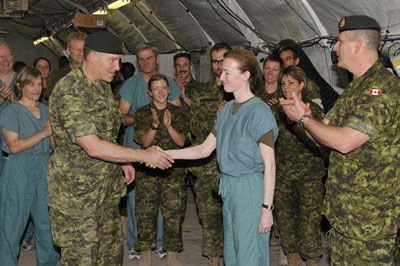
DND photo HS2010–C034–014 by Corporal Johanie Maheu
General Natynczyk visits 1 Canadian Field Hospital in Leogane, Haiti, during Operation Hestia, 18 February 2010.
The Americas and Canadian Defence Interests
Given the security component of the Government’s engagement in the Americas, the Canadian Forces and the Department of National Defence clearly have a role to play in Canada’s re-engagement in the hemisphere. Our relationships in the defence and security spheres should be based upon reciprocity with and respect for our partners in the hemisphere. My visit to South America was the first by a Canadian Chief of the Defence Staff in a decade, and the amount of high-level and staff contact between the Canadian Forces and Department of National Defence and our key partners in the hemisphere must increase if we are to have effective relations. The defence and security situation in the Americas directly affects Canadian interests, and we have much to gain by discussing issues of common concern with our hemispheric partners. Such discussions will help us to identify how the Canadian Forces and the Department of National Defence can best contribute to the security and stability of the hemisphere.
The security situation in the Americas is complex, and must be considered against a complicated backdrop of political, economic, social, health, and environmental issues. In terms of purely defence issues, the risks of interstate conflict in the Americas are currently low. However, there are still approximately 30 unresolved border-related disagreements in the hemisphere. While most of these are under control, several could trigger diplomatic incidents or lead to limited armed clashes. Nevertheless, most of the threats to the security of the Americas are non-traditional in nature – the security of the hemisphere cannot be defined in conventional military terms alone, but must be seen as multidimensional in scope. The region faces a number of critical challenges, including continued poverty and increasing socio-economic disparities that sow dissent, social discontent, and insecurity. At the same time, widespread corruption undermines the rule of law, and, by extension, security, especially when combined with weak state institutions and limited public sector capacities. And for many in the region, there are perennial threats from natural disasters such as hurricanes – including the annual devastating hurricane season that sweeps through the Caribbean – or earthquakes and other calamities. Narco-trafficking, urban violence, and organized crime threaten the entire region. Terrorism, whether domestic or international, also remains a risk. And extra-regional actors are also increasingly interested in the Americas. In addition to their growing economic and trade presence in the hemisphere, countries such as China, Russia, and Iran are challenging the traditional role of the United States in the region in sectors such as military training and cooperation and defence procurement. Venezuela’s rapprochement with Russia and Iran is but one example.
Military defence of the hemisphere is now only a small part of the spectrum of responses to these security threats, and the traditional use of national military forces is unlikely to be appropriate against many of them. However, in some of the weaker countries of the Americas, the military is often the strongest national institution, and the only reliable organ of government that has the ability to maintain internal order or mount a credible defence against transnational threats. This can lead to the encroachment of the armed forces into the civilian national security or law enforcement spheres, and it raises potential concern for civilian-military relations. The military coup last year in Honduras serves to underscore the fragility of democratic governance in some nations within the hemisphere.
The return of democracy throughout most of the region during the 1990s led to a needed reassessment of the roles and responsibilities of the armed forces in many countries. Troop numbers and budgets were significantly reduced, while many armed forces embraced professionalization, opened their doors to women and minorities, and adapted, sometimes uneasily, to functioning under civilian oversight. In a number of nations, the domestic role of the military was curbed while new international mandates were created, leading to a significant increase in United Nations peacekeeping missions. For example, since 1989, participation by the countries of the Americas in UN peacekeeping operations has increased by 750 percent, compared to 120 percent for the rest of the world. This increased international engagement is most evident in Haiti, where countries of the Americas provide the great majority of troops to the UN mission. In keeping with this new international focus, many countries of the Americas have opened peacekeeping training centres, and they actively pursue partnerships with other nations for expertise, advice, cooperation, training, and, eventually, partnership in operations. However, hemispheric multilateral cooperation is still in its infancy, as is the regional confidence-and-security-building measures regime.
The Americas and the Canada First Defence Strategy
Canada’s engagement with the Americas on defence and security issues is entirely consistent with the Canada First Defence Strategy. At its heart, this strategy is a commitment to keep Canadians safe and secure, and to ensure that Canada continues in its role on the international stage as a credible and influential country, ready to do its part. The strategy draws our attention to the complex and unpredictable strategic environment marked by such things as border conflicts, fragile states, transnational criminal networks, human and drug trafficking, unequal access to resources, and uneven economic distribution. All of these elements are present in the Americas. In light of the roles identified for the Canadian Forces – defending Canada, defending North America, and contributing to international peace and security – our engagement in the hemisphere clearly fulfils all three:
- Defending Canada – Tackling threats to Canada at their sources is vital to protect both Canada and Canadians. For example, our participation in counter-narcotics operations in the Americas directly contributes to the safety and security of Canada by preventing drugs originating from countries in the Americas from reaching Canadian streets.
- Defending North America – Engaging in the hemisphere allows us to be a strong and reliable partner in the defence of North America. Both of Canada’s partners in the defence of North America – the United States and Mexico – have considerable interests in the Americas, and events in the region increasingly affect North American security. Canada must play its part in defending the continent. Our increased cooperation with the United States and Mexico in hemispheric defence and security matters also contributes to stronger bilateral relationships with these two key partners.
- Contributing to International Peace and Security – Our engagement in the Americas requires Canadian leadership on the international stage. Countries of the hemisphere have a genuine interest in collaborating more with Canada on defence and security issues. We can play an even larger role in working with the countries of the Americas, and can lead the way in contributing to regional security.
Canadian Forces Engagement in the Americas
All of this forms the backdrop against which we must consider Canada’s defence and security interests in the Americas. We have much to offer the region, but there are also areas where we can learn from our hemispheric partners. Our engagement and cooperation in the Americas must focus upon activities and arrangements that are effective, tangible, and enduring. This means building upon the practical activities through which we are already engaged in the Americas. With no history as a colonizer, we are a credible and trusted partner for the countries of the region. We have credibility and access, where others may encounter concern and difficulty. What this means in terms of how the Canadian Forces engages in the Americas, our focus is upon contributions to three key strategic areas. First, we will contribute to regional security through peace support operations, bilateral military operational assistance, and consequence management for natural and man-made disasters. Second, we will continue to undertake defence and security capacity building and training, specifically through military education, professional development, and institutional and operational capacity building. Third, we will provide assistance in defence governance issues. This includes integrating military operations in a ‘whole-of-government’ approach, civil-military relations, minority and gender integration, military justice, ethics and human rights, transparency, white paper development, defence budget and comptrollership, and security defence reviews. By working in these three areas, we are able to pursue and support the goals of contributing to national security, contributing to regional security and stability, and supporting broader Government of Canada objectives in the region.
We have a number of useful tools at our disposal to enable our strategic objectives in the Americas. Essentially, these tools fall under our broad defence diplomacy umbrella that covers engagement, operations, and training. Defence diplomacy is an encompassing approach that the defence team – the Canadian Forces and the Department of National Defence – has developed to frame our international defence engagement. In addition to our Minister’s engagement with his counterparts, it includes such things as:
- our Canadian Defence Attaché programme;
- formal staff talks;
- multilateral fora (i.e., Conference of Defence Ministers of the Americas, Organization of American States [OAS]);
- visits by Canadian Forces and Departmental leaders to the region, as well as visits to Canada by officials from the region;
- Canadian representation at key events;
- establishing and maintaining close relations with defence attachés from countries in the hemisphere;
- promoting cooperation opportunities between Canadian defence industries and potential clients in the Americas;
- engaging academics with expertise on the Americas; and,
- using defence and other publications to disseminate our views, experiences, and models throughout the hemisphere.
Activities relating to operations and training include:
- the Military Training and Cooperation Program, which helps build the operational and institutional capabilities of member countries. (Jamaica is a particularly successful example of the positive impact this program can have);
- courses and exchanges, where other nations’ military members come to Canada, or Canadian Forces personnel travel to the hemisphere, and exercises;
- ship and air display deployments and visits;
- regular contributions of maritime patrol aircraft and naval assets in support of the United States-led Joint International Interagency Task Force (JIIATF) South counter-drug detection and monitoring operation;
- peace support operations; and,
- the development of contingency plans for a number of possible missions in the hemisphere, including humanitarian relief operations and the evacuation of Canadians abroad.

DND photo IS2010–0004–02 by Sergeant Paz Quillé.
RCAF Assistant Commissioner Bud Mercer, Rear-Admiral Tyrone Pyle, General Walter Natynczyk, and USAF General Victor Renuart, CINCNORAD and Northern Command, confer at the headquarters of the Vancouver 2010 Integrated Security Unit, 1 February 2010.
There is also scope for increased cooperation with our traditional partners. We will work closely with other like-minded countries to increase the effectiveness of our engagement in the Americas, and to accomplish joint objectives in the hemisphere. The United States is our closest ally, and has considerable interests in the Americas. We work with the US in Washington, DC, with Northern Command, and with the United States Southern Command to promote cooperative efforts in the region. This is supported with regular contact at the policy level, continued Canadian participation in US-organized exercises in the Americas, and joint implementation of initiatives and programs that serve common objectives. We also engage with Mexico, our other important North American partner – and a country that possesses unique insights into the Americas. Our concerns often coincide, creating a number of opportunities for cooperation. We will build closer ties with Mexico, particularly in the framework of the Canada-Mexico political-military talks (established in 2006), with the aim of collaborating in hemispheric defence matters. Mexico is currently experiencing significant challenges itself, for example, with criminal drug gangs and the violence they bring. However, as the outbreak of the H1N1 influenza virus has demonstrated, Mexico does have the ability to cope with a major crisis. This is exactly the time when we need to reach out a hand of friendship to work together on areas of mutual concern and interest.
There are specific issues where Canada has significant experience and expertise to contribute to the Americas. The Canadian Forces brings much experience to the table with respect to defence governance and the professionalization of military forces, as well as cooperation with other government departments. While the concept of civilian control of the military is present in most of the Americas, the ministries of defence and accompanying civilian institutions of several nations remain weak when compared to their corresponding military establishments. And regrettably, some countries, such as Venezuela, are experiencing the politicization of their armed forces. Canada’s model of defence governance and professionalism is impressive, and Canadian Forces expertise with defence governance and the conduct of a professional military could go a long way to help strengthen civilian control of the military in the region, and to help ensure that armed forces in the Americas view themselves as servants of the public good, firmly guided by the democratically-elected civilian authorities.
Peace support operations are another area in which we have much to share. As I noted earlier, nations of the Americas are increasingly participating in United Nations peacekeeping missions – particularly impressive are Brazil’s and Uruguay’s efforts in Haiti and elsewhere. Given our historic and ongoing involvement in peace support operations, the Canadian Forces has much to offer in terms of preparing for missions, command and control, and rules of engagement. Further, our efforts over the years to enhance capacity building in the hemisphere have been designed to promote and stimulate regional contributions to international peace support operations. This results in greater regional involvement in this global responsibility, and it also helps reduce the strains and demands placed upon countries like Canada (and therefore the Canadian Forces) by a high operational tempo. The ‘bottom line’ is that this global burden is more equitably shared when more nations can capably contribute to peace support operations.
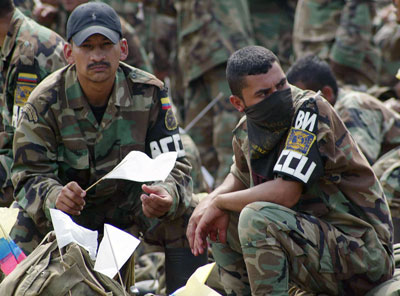
REUTERS⁄Fredy Builes⁄ RTR15U6Z
Columbian paramilitaries (AUC) wait to surrender their weapons at the Sierra Nevada de Santa Marta, 3 February 2006.
With respect to terrorism, a number of countries in the hemisphere have struggled with domestic terrorism for decades. In the past, some of these groups have threatened Canadian citizens or interests. Indeed, the Canadian government has listed Sendero Luminoso, AUC, ELN, and FARC as terrorist entities, the latter three of which mainly operate in Colombia. During my visit there last year, I discussed terrorism with my hosts, particularly how their experiences domestically might be applicable to their participation in the Afghanistan mission, and to our own deployment there. While the situations are quite different, it was a discussion worth having. We have also seen international terrorist groups, such as Hezbollah and al Qaeda, use the region as safe havens, or as a place in which to advance their causes. It is in our interest to ensure that our neighbours in the Americas have the tools they need to fight terrorism on their territory.

REUTERS⁄Ho New⁄ RTXQNJ9
FARC rebels pose with an unidentified girl holding a weapon in southern Colombia, 12 November 2009.
Finally, Canada may face some similar domestic defence challenges as those confronting our southern neighbours. Brazil is a case in point. Both our countries possess vast tracts of rugged, underpopulated terrain that is difficult to access, and that may be attractive to parties that are otherwise unwelcome. While the Arctic and the Amazon are, on the surface, vastly different, they share similar problems when it comes to maintaining a defence presence in a remote area, and when conducting surveillance and sovereignty patrols. There may also be scope to share experiences and lessons between the Canadian Forces and Uruguay’s armed forces – our navy operates in the Arctic, while the Uruguayan navy operates in the Antarctic region. Further, we have much to learn from the care that Colombia provides to its soldiers injured in combat, particularly those who have lost limbs and suffered severe injuries. Given the experiences of a number of our soldiers in Afghanistan, Colombia’s actions in supporting injured soldiers have resonance for the Canadian Forces. As these examples illustrate, there are ample opportunities to learn from our hemispheric partners and their initiatives.
I would be remiss if I did not underline that the Canadian Forces engagement in the Americas takes place against a backdrop of a wider defence and security engagement. Specifically, the opportunity exists for Canada to help modernize the hemispheric security architecture, and to ensure that multilateral efforts to address threats to the hemisphere are effective. Canada’s security is intrinsically linked to the security of the Americas, and we need to take a multifaceted approach to promoting security in the region. There are a number of avenues in which Canada can do this, although I must note that many of these are properly vested in the hands of our colleagues at Foreign Affairs, even if we in the Department follow developments with interest. First, Canada will continue to be an active player in the Organization of American States, the key political forum of the Americas, and an important venue for cooperation with our hemispheric partners on the important matters of democratic governance, multidimensional security, and integral development. In particular, Canada will continue to play a leading role in implementing the 2003 Declaration on Security in the Americas, by encouraging transparency in conventional weapons acquisition, and in promoting the strengthening of the hemispheric confidence-and-security-building measures regime.
Second, Canada will continue to work to define an appropriate role for a modernized Inter-American Defence Board that will not only reflect its link with the Organization of American States, but also its reformed nature and new ability to assist that Organization and its member states in better addressing the future defence and military needs of the hemisphere.
Third, we will continue to support the Conference of Defence Ministers of the Americas. As a past host nation of the Conference, we recognize that it supports Canada’s tradition of multilateralism and is a cornerstone of our defence engagement in the Americas. We will continue to use our participation in the Conference to strengthen Canadian defence engagement in the hemisphere in support of Canada’s foreign policy objectives, to bolster our reputation as a defence and security leader in the hemisphere, to enhance bilateral, regional and sub-regional relationships, to reinforce the existing hemispheric security architecture, to reaffirm the continued need for transparency and confidence building in regional defence and security issues, and to strengthen democratic civil-military relations in the Americas. I am very pleased with the work Canada has led in conjunction with Bolivia, the next host of the Conference of Defence Ministers of the Americas, with respect to having the OAS, through the Inter-American Defence Board, house the institutional memory of the Conference – which was formally adopted by the OAS General Assembly on 4 June 2009 in San Pedro Sula, Honduras. Although this is a relatively modest step, it will reduce the administrative burden on host nations, and create, for the first time, a link between the Conference and the OAS.
Finally, there are opportunities for further engagement in a number of other regional venues and fora, including the hemispheric service conferences (a key way for the Canadian Forces to engage with other armed forces), the Conference of Central American Armed Forces (where Canada is an observer), and the Regional Security System of the Eastern Caribbean, which promotes cooperation between member states.
Conclusion
Canada is a country of the Americas – this is our neighbourhood and we want to be good neighbours, engaged in a positive and constructive manner with those who share the hemisphere with us. I recognize that the security environment in the Americas has changed significantly in the last two decades, and it continues to evolve. The defence and security issues at play in the region are challenging, and they require multifaceted approaches for which traditional armed forces may not always be appropriate. But these issues have an obvious impact upon Canada’s defence and security interests, and the Canadian Forces clearly has a role in meeting the current and potential challenges they pose. The Canadian Forces and Department of National Defence are willing and prepared to continue building relationships in the region, based upon reciprocity, respect, and trust – with the aim of developing strong and long-lasting relationships. We have a role to play, one that is nested within the Government’s wider engagement in the Americas, and a ‘whole-of-government’ approach.
I am pleased to have been able to visit some of my counterparts and other senior officials – not only to be able to build positive personal relationships with them, but also to understand first hand the importance of the hemisphere to the Canadian Forces. In many ways, we have been quietly working with our regional partners for some time through initiatives such as the Military Training and Cooperation Program, staff talks, and participation in the three hemispheric service conferences. All our activities in the region neatly dovetail with both the Government’s engagement in the Americas, and the Canada First Defence Strategy. There is much scope for the Canadian Forces to build upon existing engagements and to create new opportunities for working with our neighbours and partners in the hemisphere. Our continued and future engagement in the region, while modest, will be tangible and enduring. The Americas is a vast, diverse, and dynamic place. While challenges remain, the current story of the Americas is generally one of hope. The Canadian Forces is ready and able to enable our Government in its important endeavour of re-engagement, and to work with our partners in the Americas to build upon the steady progress that has already been generated in the region.
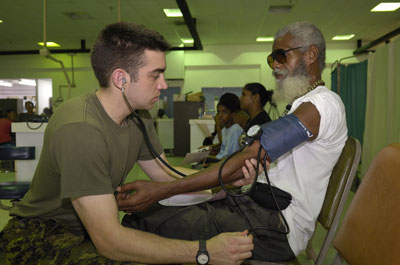
DND photo IS2008–2524 by Sergeant Paz Quillé
Master Corporal Matt Macaulay, a medical technician from St. John’s, Newfoundland, takes a blood pressure reading in Trinidad and Tobago as part of Exercise Continuing Promise, 2 November 2008.
![]()
General Walt Natynczyk, CMM, MSC, CD, an Armoured officer, is Canada’s Chief of the Defence Staff. He holds a Business Administration degree from Royal Roads Military College and Collège militaire royal, and he is a graduate of the Canadian Forces Command and Staff College, the UK All Arms Tactics Course, and the US Army War College.
Nancy MacKinnon is a special advisor to the Directorate of Western Hemisphere Policy at DND, and was formerly a member of the Canadian Executive Secretariat that organized the VIIIth Conference of Defence Ministers of the Americas, held in Banff, Alberta, in 2008. She holds a Bachelor of Journalism and Political Science, and a Masters of Arts in International Affairs.






